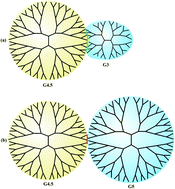Interactions between oppositely charged dendrimers
Abstract
The interactions between cationic (G3, G4, and G5) and anionic (G4.5) poly(amidoamine) (PAMAM) dendrimers were investigated by

* Corresponding authors
a
School of Life Sciences, East China Normal University, Shanghai, People's Republic of China
E-mail:
yycheng@mail.ustc.edu.cn
b School of Life Sciences, University of Science and Technology of China, Hefei, Anhui, People's Republic of China
c
CAS Key Laboratory of Soft Matter Chemistry, School of Chemistry and Material Science, University of Science and Technology of China, Hefei, Anhui, People's Republic of China
E-mail:
twxu@ustc.edu.cn
d Department of Polymer Science, University of Akron, Akron, Ohio 44325, USA
The interactions between cationic (G3, G4, and G5) and anionic (G4.5) poly(amidoamine) (PAMAM) dendrimers were investigated by

 Please wait while we load your content...
Something went wrong. Try again?
Please wait while we load your content...
Something went wrong. Try again?
J. Zhang, J. Hu, X. Feng, Y. Li, L. Zhao, T. Xu and Y. Cheng, Soft Matter, 2012, 8, 9800 DOI: 10.1039/C2SM26353J
To request permission to reproduce material from this article, please go to the Copyright Clearance Center request page.
If you are an author contributing to an RSC publication, you do not need to request permission provided correct acknowledgement is given.
If you are the author of this article, you do not need to request permission to reproduce figures and diagrams provided correct acknowledgement is given. If you want to reproduce the whole article in a third-party publication (excluding your thesis/dissertation for which permission is not required) please go to the Copyright Clearance Center request page.
Read more about how to correctly acknowledge RSC content.
 Fetching data from CrossRef.
Fetching data from CrossRef.
This may take some time to load.
Loading related content
